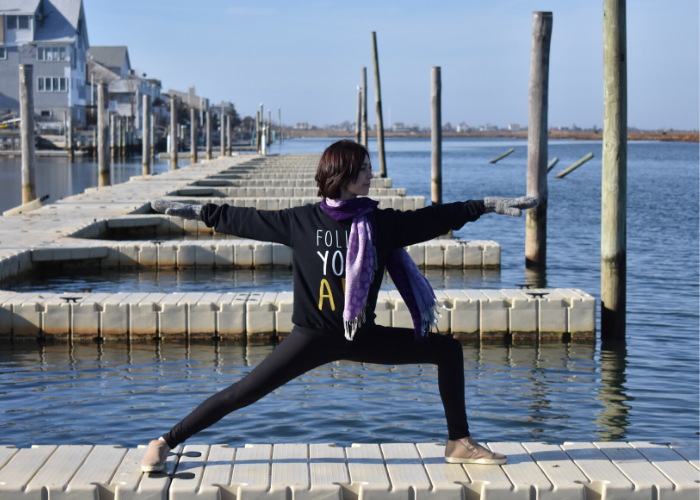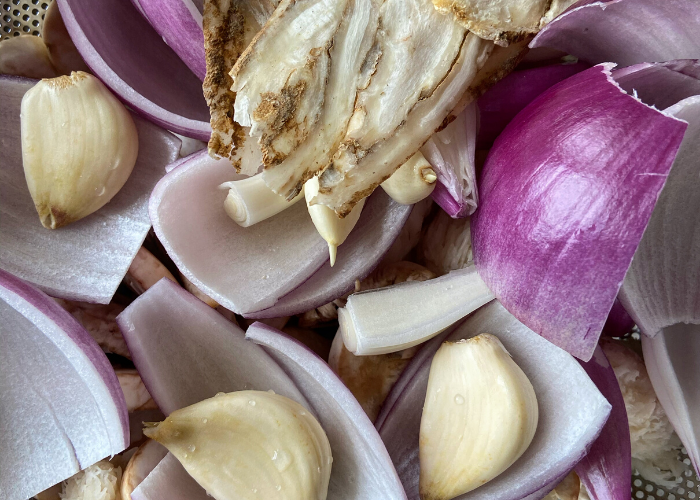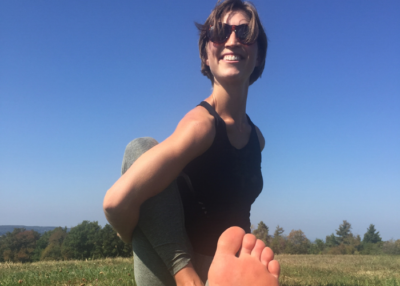Virabhadrasana & Xiao Yao San
Lately often when I practice yoga my mind starts wandering (tsk tsk yogi) to thinking about herbs & how poses & formulas often embody similar intentions. Here is a little tidbit on how I think xiao yao san & Virabhadrasana are alike!
First let’s talk about the classic story behind the yoga pose Virabhadrasana also known as Warrior Pose.
The classic story begins with a romance between Sati (the daughter of King Daksha) and Shiva. King Daksha was not a fan of his daughters love interest. In fact he despised him very much. It was said that Shiva was the antithesis of King Daksha. The young man had dreadlocks and spent the majority of his time meditating on mountain tops and in graveyards. He was akin to Sati, who herself was eccentric and somewhat introverted. King Daksha, on the other hand, an esteemed member of society, was very conventional, polite, outgoing, by the rules and organized.
Despite not having her father’s blessing, Sati married Shiva. Feeling disappointed and angry, King Daksha threw a huge party and spitefully invited everybody but excluded his daughter and son-in-law.
Upset, Sati attended the party despite her dads unwelcoming behavior. Her father wouldn’t even talk to her at the gathering. Sati was so mad, she swiftly made a decision to rid herself of her physical body, wanting to dispose of the connection between her and the king. She sat down at the party and started meditating to build a fire inside of her. Eventually combusting into flames and relinquishing her physical body to the ground.
When Shiva heard word of his wife’s sudden and unnecessary death, he was so enraged that he ripped out all of his dreadlocks, threw one on the floor and created warrior Virabhadra. He led his newfound warrior to his father-in-laws home where he killed everybody, beheaded King Shiva and drank his blood.
The warrior poses we practice today derive from Virabhadra’s attack at the gathering. Warrior II is said to be Virabhadra standing with his sword ready to strike.

Ok so it got a little dark there for a minute but now let us talk about chinese herbs!! 🙂
There is a formula in Chinese medicine known as xiao yao san or Rambling Powder/Free & Easy Wanderer Powder. It is a very commonly used therapy for conditions such as premenstrual syndrome, perimenopausal syndrome, pelvic inflammatory disease, uterine fibroids, cirrhosis, hepatitis, gastritis etc.
Though we recognize xiao yao san to treat the above biomedical indications and more, in traditional chinese medicine we treat based on pattern diagnosis.
What did this mean? We treat based on what we see.
Symptoms indicated for this formula include but are not limited to hypochondriac pain, headache, vertigo, a bitter taste in the mouth, dry mouth, fatigue, reduced appetite, irregular menstruation, and distended breast.
Xiao yao san works to alleviate the symptoms/conditions and regulate the disharmony by spreading the liver qi, strengthening the spleen and nourishing the blood.
The mechanism of this pattern is that the liver qi is constrained. The liver governs the free flow of qi, but it can become impeded due to distress, and an inability to freely express emotion (Barolet, Bensky, Ellis, Scheid, 120-21).
Subsequently, once the liver is constrained, we can assume the Spleen has also been compromised. Therefore we can not simple dredge the liver and relieve the constraint. This requires strength but also gentleness and nourishment. A peaceful warrior, if you will.
The Liver governs dredging and discharging.
According to its natural disposition,
it favors smooth, unimpeded
out-thrusting and resist
being curbed and constrained…
When a person is unable to
freely express their emotions,
the liver qi becomes constrained,
(Barolet, Bensky, Ellis, Scheid, 121).
When the liver and spleen are both deficient,
wood cannot dredge earth.
If the liver is unable to dredge
and drain to facilitate an orderly qi dynamic,
if the spleen is unable to strengthen to
the transformative functions and generate
transformation, the manifestations
of constraint take shape…
(Medical lecture notes of Qin Qian Zhai – Qin Bo Wei).
So how do these two medicines, one herbal intervention and one physical, connect to one another?
Let us circle back to the story of warrior pose.
The conflict between the characters, Virabhadra, Sati, Shiva & Daksha, represents everybody’s battle between themselves and their ego.
“Yoga is the practice of tolerating the consequences of being yourself”
-bhagavad gita
In other words, yoga is about accepting all aspects of oneself. Rather than writing off the things we don’t like about ourselves, making space and allowing them to exist but not take over our lives. The ability to look in the mirror instead of denying traits that are inherently a part of us but that we don’t love or don’t want to face. Remembering that we are all connected and acknowledging that the things that make us react in other people are really just a reflection of what is inside ourselves.
King Daksha had such a problem with Shiva marrying his daughter because he embodied everything he hated about himself…everything he was lacking. He felt so displeased with the situation that he cut off his nose to spite his face. He lost his daughter, Sati.
You can be happy, or you can be right – Gerald Jampolsky.
King Daksha, Sati & Shiva could have lived happily ever after. Sati even made an attempt to go to the party. But things went terribly wrong due to stubbornness and ego and in the end, everybody lost.
The pose Virabhadrasana II takes on a different variation in Viparita Virabhadrasana, also known as peaceful or reverse warrior.

Vira II embodies integrity, strength, fire and power over the mind. Virabhadra was led by Shiva to the party to kill King Daksha (who represents the overwhelming power of the ego). Viparita Virabhadrasana (seen in the picture on the right) maintains the integrity of Vira II while also inviting space for humble resolve. It allows peace for the battle between the ego and the truth. The peaceful warrior surrenders to the possibility that opens after the power of the ego dissolves. By only standing in Vira II we are strengthening, building fire and reserve, and warming the ministerial fire. Though when we lean back, we allow our eyes to soften and rise up towards the sky rather than out over our fingertips into the distance with fierceness. We stop the fire from burning too strongly, surrender to trouble both outside and inside us and become vulnerable to the uncertainty of external events and stress. We reach back for support to lean on experience, again moving inward with acceptance rather than reaching out with blame and bitterness towards the world.
The liver & the ego.
The liver becomes constrained when there is a disharmony between the way we see ourselves/ the way we expect things to be, and reality. Much like stress and anxiety occur when thoughts find themselves lost or distracted in the past and/or the future. The liver qi is unhappy when there is not peace.
So let’s break down xiao yao san and warrior pose.
Xiao Yao san is made up of the following herbs:
chai hu/ bupleurum/ Radix Bupleuri Chinensis dang gui/ angelica root/ Radix Angelicae Sinensis bai shao/ peony/ Radix Paeoniae Lactiflorae bai zhu/ atractylodis/ Rhizoma Atractylodis Macrocephalae
fu ling/ poria/ Sclerotium Poriae Cocos gan cao/ licorice/ Radix Glycyrrhizae Uralensis bo he/ mint/ Herba Menthae Haplocalycis sheng jiang/ ginger/ Rhizoma Zingiberis Officinalis Recens
A major indication of disharmony of the liver qi is pain or tightness in the rib side and chest. Also a stifling sensation in the chest and/or trouble taking a deep breath.
The liver transverses both sides of the body/gan wei ying zhi yuan
In Viparita Vira the stretch in the side body allows for the liver qi to course smoothly, emolliating the liver qi. The ribs open and the chest is free and expansive. Breathing is deep and complete.
The liver is delighted by orderly reaching/gan xi tiao da
The intense stretch is like the chief herb, chai hu (spreading the liver qi and relieving constraint, out-thrusting) as stagnant stress spreads up from the ribcage and is released out through the long outstretched arm and fingertips (letting things go).

And when we gather our core and inhale to rise back up into Virabhadrasana II, we welcome balance between all the different aspects and layers of our true selves, even the parts we don’t like. We balance the yin and yang aspect of the liver. “The liver is yin with regards to its essence and yang with respect to its function/ gan ti yin yong yang,” (Barolet, Bensky, Ellis, Scheid, 121).
Fu ling, and bai zhu act like the strength of Vira II, “curbing the tendency of wood (liver) to invade earth (spleen) and augmenting the spleens transformative and transportation function supports the treatment of underlying blood deficiency.” The liver qi is coursed while simultaneously the middle jiao and the blood are being strengthened/nourished. The dui yao of fu ling and bai zhu serve as the Vira II because it is the base, the earth, the spiritual pivot. If the spleen stomach is not performing adequately, all other systems will suffer (Barolet, Bensky, Ellis, Scheid, 120).

The liver governs the making of strategies/gan zhu mou lu.
Virabhadra is a warrior. He stands in Virabhadrasana II under the command of Shiva, ready to strike, but also at peace.
Liver qi flows to the eyes/gan qi tong yu mu
When the liver is harmonious, the eyes are able to differentiate the five colors/gan he ze yan neng bian wu se.
When the liver is happy, it is in in part a result to the lack of confusion between one’s true self and his ego. We can see beyond our personal trauma and react to external stimulation and stress with rational thinking and with a level head rather than based on confusion and emotion.
Let him hold all the senses under control
and concentrating the mind, surrender to me,
for he who has his senses under
his sway has knowledge abidingly set.
-Bhagavad Gita
It is through withdrawal that complete
control over the senses is gained. It purifies
the mind, increased austerity (tapas)
gives self confidence, freedom from illness
and the mental qualification for
final identification (Danielou, 70).

Bo he is the breath and the drishdi.
“With its penetrating nature & light cooling, it (bo he) excels at moving over the face & head.” (Transforming the Significance of Medicinal substances).
The gaze extends out over the extended hand. In Viparita Vira the face and neck are open and long. Dislodging heat due to constraint from the rib side.
The eyes are bright and see clearly.
In yoga the breath & drishdi compose two thirds of the focus (the third being the bandhas). The intention of the two different drishdis between Vira II and Viparita Vira completely transforms the actions of the pose.
Together with bai shao and chai hu, bo he “allows liver qi to flow freely…for liver constraint with symptoms such as a stifling sensation in the chest or pain and distention in the flanks,” (Bensky, Clavey, Stoger, 47).

Sheng jiang is the movement of the arms/backbend from Vira II to Viparita Vira. Sheng jiang serves as the envoy, “harmonizing the stomach and preventing the development of rebellious qi.” It regulates the transition from fierce warrior to peaceful/reverse warrior. Again balancing the yin variation of the the pose (peacefulness/surrender) with the yang aspect (fierceness/fight mode).
This very balance encompasses the primary mechanism of Chinese medicine, to balance yin & yang. It embodies the transitions of variation in the pose. If the yogi were to stand in Vira II forever, he would develop an excess of fire (much like Sati did purposely). Falling back into Viparita Vira cools the fire down and stops the ego from becoming too empowered as the attack warrior with his sword. Displaying how easy and possible it is for the ego to take over and control our lives if we allow it.
We need a fire in the body, but want it to stay where it belongs; tame it. It can become replete and wreak havoc or if their is a weakness in the middle jiao, the natural fire that we utilize to thrive can rise up and become pathological. Much like our relationship with our ego, knowing that it is inherently a part of us but having the ability to keep it in check and not let it have a negative effect.
“When the liver suffers from tension, quickly take sweet flavors to relax it.”
“When the liver requires dispersion, quickly take acrid flavors to disperse it.”
“Use acrid flavors to tonify it and sour flavors to drain it.”
Basic Questions, Ch. 22
The balancing nature of the formula makes it suitable to treat the pattern that requires both movement of the liver qi and nourishment of the middle and the blood.
If there is blood, this empowers the harmonization of qi/ xue you he qi zhi li.
Since the blood is damaged as subsequent to the liver qi constraint effecting the spleen, the blood also needs to be nourished.
Bai shao and dang gui “work together to nourish the blood, and strengthen the liver so that it may discharge it’s functions more smoothly,” (Barolet, Bensky, Ellis, Scheid, 121).
“Bai shao enters the spleen channel and supports the spleen when it is accosted by rebellious liver qi…its dual tonification and drainage allows the liver to soften up enough to accept the blood and store it…” (Bensky, Clavey, Stoger, 756).
Dang gui serves as an herb “for the qi within the blood… When the blood is sufficient and moves harmoniously, the qi will also circulate properly,” (Bensky, Clavey, Stoger, 751).
Although Dang gui is warm, it can still be used if there is heat with blood deficiency, because, as it can generate blood, it enriches the yin, and by enriching the yin, it can reduce heat,” (Essays on Medicine Esteeming the Chinese and Respecting the Western, Zhang Xi-Chun).
This mechanism relates back to that idea of vacuity fire developing when there is qi stagnation, and the balance between the transitions between Vira II & Viparita Vira. Bai shao & dang gui serve as an additional bridge between ego & the truth/ qi stagnation & free flow. It also resembles the actions needed to remedy the global and layered effects of stress and disharmony on the body.
When the liver qi courses smoothly, when the blood & middle jiao are adequately nourished & strong, when the fire remains in it’s source, when the warrior can stand upright with integrity but also wander freely in peace, when the ego is not in control, then we can have equanimity.
sandarsita svatma sukhava bodhe
samsara halahala mohasantyai
*Disclaimer – This post is not intended to be a substitute for professional medical advice, diagnosis or treatment. Always seek the advice of your primary care physician or other qualified health care provider with any questions you may have regarding a medical condition or treatment and/or before undertaking a new health care regimen. Please never disregard professional medical advice or delay in seeking it because of something you have read on this website.
Works Cited
Bensky, D., Clavey, S., Stoger, E. Chinese Herbal Medicine: Materia Medica. Eastland Press Inc., 2004.
Danielou, Alaine. Yoga: The Method of Reintegration. Kessinger Pub Co, 2005.
Flaws, Bob. Statements of Fact in Chinese Medicine. Blue Poppy Press, 2004.
Barolet, R., Bensky D., Ellis, A., and Scheid, V. Chinese Herbal Medicine:Formulas & Strategies. Eastland Press, 2015.
Lecture. Lennessa Shantaya. Kaivalya Yoga Academy. 2016.




